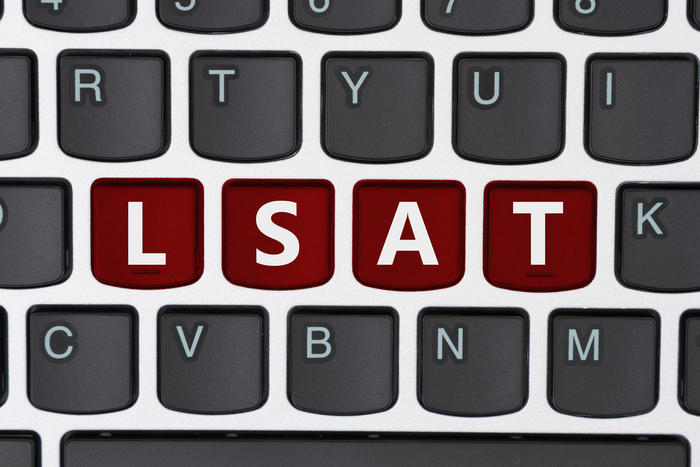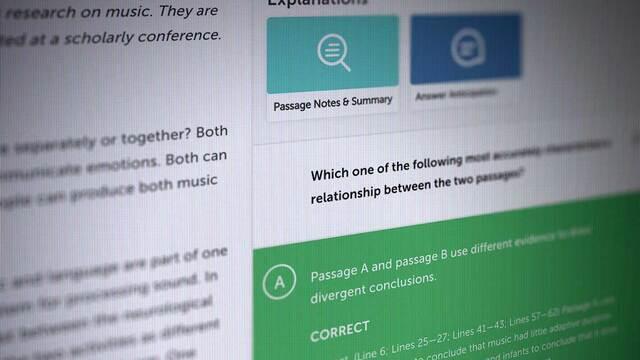There are many standardized tests, each of which tests a student's ability to display different or unique skills. While there are many exams, the GMAT and LSAT, which respectively test students looking to enter the fields of business and law, are among the most unique and challenging. T
Most MBA programs require students to take the GMAT exam, and most Juris Doctor programs require students to take the LSAT. So, what's the difference between the two tests?
The LSAT
To begin, we'll start with the LSAT (formally known as the Law School Admission Test). The LSAT is designed to test a student's ability to analyze logical arguments, show their reading comprehension, and write with precision. We will take you through each section of the exam to give you an idea about what to expect on test day.
Structure
The LSAT is a two-day test where you'll be working on the multiple-choice section one day and the writing section on another. The order depends on the day you'll be taking the exam. This prevents cheating and makes sure students don't have time to converse with others about previous questions or sections of the exam.
In total, there are five sections on the test. For each section, students have 35 minutes, and time does not carry over between sections. This is why students must focus on pacing as part of LSAT preparation. With the wrong pacing, a good score is unobtainable.
Logical Reasoning
On the LSAT, there are two logical reasoning sections. In each area, there can be 24, 25, or 26 multiple-choice questions. So, how does this portion of the exam work?
Students are presented with an argument for each question. These are short arguments, usually involving a situation between two or more hypothetical individuals. While every question presents students with a unique argument, there are five ways for a student to respond.
Some questions ask students to find the assumptions within an argument. This is a piece of information that isn't based on fact or logic; instead, it's a matter of opinion or inferred information. These questions are typically more comfortable than the other two because they are more obvious and found within the prompt. Therefore, a little extra focus on the reading comprehension section of the exam can also benefit students in the logical reasoning section.
Another prompt is to find holes in an argument's logic. This is similar to finding assumptions or logical fallacies. For example, if someone is making a claim without evidence, they're not making a logical approach. Still, these prompts are complicated. You'll need to distinguish between the right way of approaching situations to discover an answer.
Some questions will also ask students to come up with an alternative solution to an argument. The good news is that the test presents you with a handful of options. You'll need to review the statement and find a solution thoroughly. Similar prompts include asking a student to develop a parallel argument or finding strengths to boost an argument.
Logic Games
The logic games section of the LSAT is a tricky section that's hard to prepare for. The current LSAT has one of these sections, and it includes four little games.
These questions are hard to describe, so we'll give you a fun example:
George, Sally, Mary, Jake, and Tom own cars. Their cars are green, red, blue, yellow, and black. George doesn't own a red or yellow car. Sally has a blue car.
Jake loves the color green but had to settle for yellow; Tom happily owns a green car, and Mary had to choose between red and black. If every car is a different color, what color is Mary's car?
While this is a simple example, there are 22-26 questions and about 4-6 questions for each game. Some of the questions will also modify the information within the game, which forces students to work with additional information to draw new conclusions about the group. For example, another question could expand on the type of car each person owns.
Reading Comprehension
The reading comprehension portion of the LSAT exam is all about reading from passages and answering questions. There are three passages ranging from 400 to 500 words and a comparative reading section that contains two shorter passages. Students are tasked with answering 5-8 questions per passage, which creates a total of 26-28 questions.
The reading comprehension section is one of the more manageable sections of the LSAT. This is because the answers are within the passages. Students will have to discover the author's point, find specific information, draw a conclusion, or comment on the structure of the passage. The passages mostly relate to law, but there are some exceptions. You'll come across questions in social science, physical science, humanities, law, and the arts.
There used to be four 400-500 word passages in this section, but a change was made back in 2007. The comparative reading section features two short passages that have a different perspective on a topic. This is one of the most demanding areas of the LSAT because students need to find similarities and differences found within them. This section is also found on the SAT and ACT.
Writing Sample
The writing sample of the LSAT is the most straightforward section. It's the last part of the exam and gives the students a topic with two decisions. Students must choose a decision and create an argument detailing why they're correct. This section has no right or wrong answers.
What makes this section unique is that it's not always factored into the overall LSAT score. Instead, the LSAC sends the writing sample to colleges to consider. Because students typically create an application essay, the usefulness of this section is debatable. Some schools use it, and others don't, so we recommend looking into which group the school you're applying to falls into.
Scoring
The LSAT is complicated when it comes to scoring. The scores are distributed along a bell curve, which determines the percentile a student falls into. The scoring is complicated because the number of questions determining each percentile is predetermined before students take the exam. This means that scores between 120 and 180 are distributed along the bell curve. For example, 150 and 160 can be separated by ten questions, and only four questions might separate a score of 170 and 175.
Still, the score is straightforward in some ways. Students can score between 120 and 180. The 50th percentile is typically above 150, and the 99th percentile is typically around 166-167. Students that score above a 177 usually make it into the 99.9th percentile.
In summary, the LSAT is a challenging exam that helps law programs determine if a student is ready for their first year. For this reason, the LSAT is the best option for students seeking a career in law or admission into a law program.
Variable Section
The LSAT also contains one unscored section. Students are given 35 minutes to complete this section, and they're not told which one it is. This is because it could skew the information. Still, this section is typically more complicated than the other sections. This section is used to test out new and experimental questions.
The GMAT

The GMAT, or Graduate Management Administration Test, tests students' ability to read and write, analyze information, and perform math. These tests are typically used to determine a student's eligibility for MBA programs. So, while the LSAT is for law students, the GMAT is for business students.
Structure
The GMAT consists of four sections. The sections include an analytical writing assessment, integrated reasoning, a quantitative section, and a verbal section. The writing and reasoning sections of the exam are 30 minutes long, while the quantitative and verbal sections are 62 minutes long.
Analytical Writing Assessment
The analytical writing assessment is similar to the writing sample on the LSAT exam. Students are given an argument to analyze and must come up with a critique of that argument. The section is 30 minutes long, and students must display clear writing skills and understanding of logic.
Integrated Reasoning
The integrated reasoning section has been around for about eight years, making it a recent addition to the exam, and tests a student's ability to evaluate data. The section consists of 12 questions, and there are four different types depending on the prompts. Students have 30 minutes to complete this section.
Students will be tested on their ability to analyze a table of data, a two-part analysis of a topic, multi-score reasoning, and graphics interpretation. For these questions, students must choose the question that makes the statement correct.
The graphics interpretation questions include a graphic image students need to analyze, which is similar to questions based on a table of data. The multi-score reasoning questions present students with multiple sources of information to answer multiple-choice questions. Finally, the two-part analysis questions have two components for students to analyze.
Quantitative
The quantitative portion of the GMAT is one of the most rigid sections. Students don't have access to a calculator and have 62 minutes to answer questions about algebra, geometry, and general arithmetic. Work must be done on graph paper, and everything is done by hand with an erasable pen.
In this section, there are two different types of questions. Problem-solving questions test a student's ability to solve quantitative problems, similar to what you'll find on tests like the SAT and ACT. What makes the GMAT unique is the inclusion of data sufficiency questions. While these questions test for math, they also make students choose between relevant and irrelevant information.
Verbal
The verbal section of the GMAT includes a handful of different questions. There are questions for reading comprehension, sentence correction, and reasoning. Every question has five answers to choose from, and students are given 62 minutes to complete the section.
The reading comprehension questions range from one paragraph to multi-paragraph questions. Students have to use the information presented within the prompt to answer questions. The sentence correction questions present students with grammatically incorrect sections, and reasoning questions focus on reasoning skills.
Scoring
The GMAT gives students a score between 200 and 800. The score is in increments of 10, and student scores are distributed on a bell curve. The standard deviation is about 120, which makes the percentiles larger than the percentiles of the LSAT. For example, the 68th percentile includes scores between 430 and 670. This gives students a little more room for error and gives students with high percentile scores greater separation from students with lower scores.
LSAT vs. GMAT: Which Exam is Right for You?
The LSAT and GMAT are difficult tests and both require hundreds of hours of preparation. This makes it hard to take both exams. Furthermore, being prepared for the LSAT doesn't mean you're ready for the GMAT and vice versa. So, how do you know which test is right for you? Don't panic; the answer is quite simple.
If you're looking to pursue a career in law, we recommend focusing on the LSAT. Even if law schools accept a GMAT score, the LSAT is the better option for law programs. Plus, most schools have the average LSAT scores of their students listed to give you an idea of how well you need to do to gain entry. A high LSAT score can also earn you grants or scholarships.
While the LSAT is excellent for law schools, the GMAT is the exam of choice for students looking to enroll in MBA programs. The exam is business-focused, and the top business programs have the average scores of their students listed to show you how well you need to do for admission. Like the LSAT, scholarships and grants are available for students that score well.











